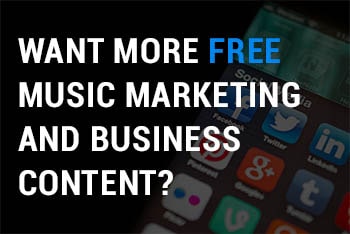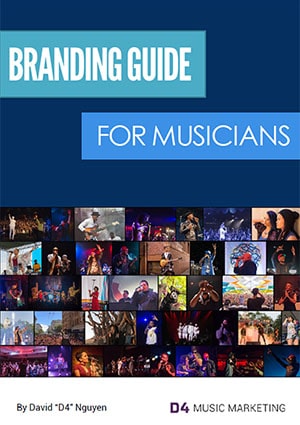
“Your music is the last thing that matters. Once they listen to your music, your music it the only thing that matters.” – Lisa Lepine (Music consultant)
It’s normal to think that your music is the most important asset you have as a musician. I mean, it is but it isn’t. Your music is only important if you can actually get people to listen to it, and it’s become increasingly harder to get someone to press play for the first time in this new digital world.
Many think being a musician means throwing some songs on some social media accounts and hope that something will magically catch on. Yeah, that’s not happening.
The fact is, there’s just so much great talent out there competing for attention that it’s not easy for musicians to stand out of the clutter. With so many options for music and entertainment, people have to make judgments and decisions about what they may or may not like before actually hearing the music.
This means it is wise for musicians to invest time in effectively communicating what their music is all about, and what makes it special before potential fans even hear it.
To peak people’s interests, you have to put out written and visual signals to convince people to take that crucial first step. That’s only half the battle because after they finally listen to your music, it’s still not guaranteed that they’ll like you as an artist. However, the better job you do of communicating what makes you special and interesting, the more likely listeners will like what they hear and become a fan.
This is why branding and marketing are so important. It’s about effectively communicating why people should be interested and intrigued by you before they even listen to a single song. This is why establishing a brand is key to building a loyal fan base and a sustainable career as an independent musician.
In this blog, I will go over the basics of branding for musicians, so you can start thinking about how you want to create and build your brand in order to rise above the clutter and attract your ideal fans.
What is a Brand?
“Cause people don’t buy music in this day and age, they buy the brand.” – Logic
You hear this word thrown around all the time. And while we can all name our favorite brands, a deep understanding of what a brand is, I believe, not something the average person really thinks about.
We tend to think of ‘brand’ only within the context of business, but the concept of a brand can actually be applied more broadly. A brand can be a group, organization, individual person and even a city. As a musician, you are a brand as well, regardless if you acknowledge it or not.
There are a number of different ways of looking at a brand, so I will go through them all in detail to give you a complete perspective on what it is.
Brand Definition
Since the concept of a brand can be unclear, it’s helpful to use multiple examples when defining the term ‘brand’.
According to Wikipedia: A brand is a name, term, design, symbol, or other feature that distinguishes one seller’s product from those of others.
A brand is the essence that makes something or someone distinguishable. It is what makes you unique. You can think of brand as a reputation, shared beliefs or opinions about someone or something. A brand can also represent the emotional and psychological relationship it has with the audience or customers.
A brand is not a tangible or physical thing, but it can be represented externally through symbols like your artist name. Sometimes people will think your logo is your brand, which is partially true. Your logo is only a symbol or reflection of your brand, but not the brand itself. Your logo represents your identity, but the brand is the meaning or emotional response people get from seeing it.
Components of your brand can include your:
- Stage or artist name
- Logo
- Website
- Music
- Bio
- Physical appearance
- Style
- Colors you use
- Social media posts
- Video content
- Other artists you work with
- Who you associate yourself with
- Stage presence
Brand as a Promise
You can think of a brand as a promise that carries certain expectations.
This promise is essentially your brand identity and what you stand for. After all, you need to stand for something in order to deliver on that promise. Establishing this early on will help guide your business decisions based on the expectations you have put forth through your brand.
For example, if you project yourself as a pro-vegan musician because it is an aspect of your personal identity, you’re making a promise or setting expectations that you’re not going to eat meat or promote the killing of animals.
The brands that are able to follow through on their promises and meet expectations will earn trust and loyalty from their fans and followers. This trust will lead to a stronger emotional connection with fans, as well as strong fan relationships.
Contrarily, not following through on promises you have made through your brand results in a break of trust and often a lost fan. This means if you’re caught eating a double-double at In-n-Out Burger as a pro-vegan musician, your brand is going to be tarnished.
Brand as a Story
Marketing guru Seth Godin likes to talk about the brand as your story. Everyone’s story is different, but what makes people receptive to a specific brand is when they see parts of their own story within it. Have you ever had songs resonate with you so much that it felt like they were written specifically for you? That’s when a fan feels a deeper emotional connection to the brand.
When talking about a brand as a story, it doesn’t mean telling your whole life story. Think of your brand as more of a plot synopsis or the theme. The actual full story is what is played out through your interactions with your fans and what you do over the course of your life and career.
Seth goes on to say your brand is someone else retelling your story through their own perceptions, which is unfair because it’s based on another person’s perception, prejudice and lack of information. When someone brings up your name or brand, they are going to recall and retell it the way they understand it (brand image), which is usually never going to be exactly how you want it to be told (brand identity). The goal is to bridge the gap between brand identity and brand image through brand alignment.
Brand Components
To break it down, a brand has two general components:
1) Brand identity
2) Brand image
Brand identity is the narrative you establish and have control over. This identity is a reflection of the core values and beliefs that you’ve cultivated through your life experiences. It’s what you stand for.
Brand image is how the public or individuals perceive you. Brand image will vary for each individual who experiences and interacts with your brand, but perceptions of a brand can also be collectively shared. You don’t have full control over how your image is perceived and interpreted, but you can influence your image through the process of branding.
Once you establish your artist (or brand) identity, the goal of branding should be to make sure your brand identity is aligned with your brand image. This is called brand alignment. If there’s a disconnect, it indicates a problem.
What is Branding?
Now that you understand what a brand is, it’s time to get into branding. As you might have guessed, branding is the strategic process of establishing and building meaning to influence the perception of your brand.
According to Wikipedia: Branding is a set of marketing and communication methods that help to distinguish a company from competitors and create a lasting impression in the minds of customers.
The goal of branding is to create a consistent perception about who you are as an artist that strategically highlights specific elements of your authentic self to attract your ideal fans who resonate with you. Also, you want to align your brand identity and brand image to create a distinct and consistent signal that separates you from other artists.
I like to think of branding as having two parts, passive and active.
Passive Branding
The passive side is doing things to communicate your brand identity that doesn’t involve direct interaction with your audience. This includes a lot of the basic things mentioned above:
- Stage name
- Logo
- Website
- Music
- Physical appearance
- Style
Active Branding
On the other hand, the active part of branding involves you interacting with your audience directly to influence or reinforce your image while nurturing the emotional connections with fans. Generally speaking, I like to look at marketing as the active component of branding. This includes the type of content you post on social media.
I see branding as a form of strategic and simplified communication with a strong emphasis on brand alignment or making sure all the brand assets are communicating the same thing.
When setting the foundation of your brand identity, the idea is to communicate the following as easily and clearly as possible:
- Who you are
- What you do
- What you stand for
- Who you appeal to
- Is there anything that makes you special and interesting
Summary
Ultimately, branding is about how you make people feel about themselves when they engage with your brand. Choosing a brand is an emotional choice (most of the time), so your branding should elicit strong emotions from your ideal audience. Your brand should be a natural manifestation of your values and identity, but being strategically focused to make fans feel a certain way can be more effective.
Remember that as a brand, you serve as a signal or extension of someone else’s identities, beliefs and values. This is why people blast their music loud for others and proudly wear band merch. So the more clearly a brand or artist identity is defined, the easier it is for someone to resonate with it.
The biggest challenge is that not everyone is going to perceive your brand the same way, but it’s your job to consistently and persistently amplify your brand the way you want. At the same time, making sure all the brand assets are in alignment to communicate the same message.









Thank you for this article! I’m trying to get a handle on this concept of branding.